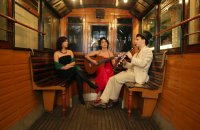
Éva Bodrogi - voice Katalin Koltai - guitar Zsolt Bartek - clarinet
The long-standing cultural links between Paris, Rio de Janeiro and Buenos Aires served as inspiration for our musical journey. Our guides for this voyage were some of the most popular Argentinean, Brazilian and French composers from the first 60 years of the twentieth century (Piazzolla, Satie, Villa Lobos, Ginastera, Ovalle). Their works also inspired our improvised interludes. As our musical journey unfolded from concert to concert, we noted that the sounds and places of our own hometown, Budapest, became evermore interwoven into the work. We came to understand that we were being influenced not only by the music of the three foreign cities, but also by our own environment as well.
Cultural background:
Brazilian composer Heitor Villa-Lobos set out from his homeland, ardently believing himself a modernist. He arrived in Paris, in the world of Montmartre’s Années Folles, and soon was rubbing elbows with the likes of Erik Satie and Jean Cocteau. In this new environment, however, his music was no longer considered modernist. Instead, audiences were intrigued by the artist’s "exotic" background and the musical traditions of his distant native land. Villa-Lobos eventually became known as "Brazil’s national composer", in great part as a result of his experiences in Paris.

